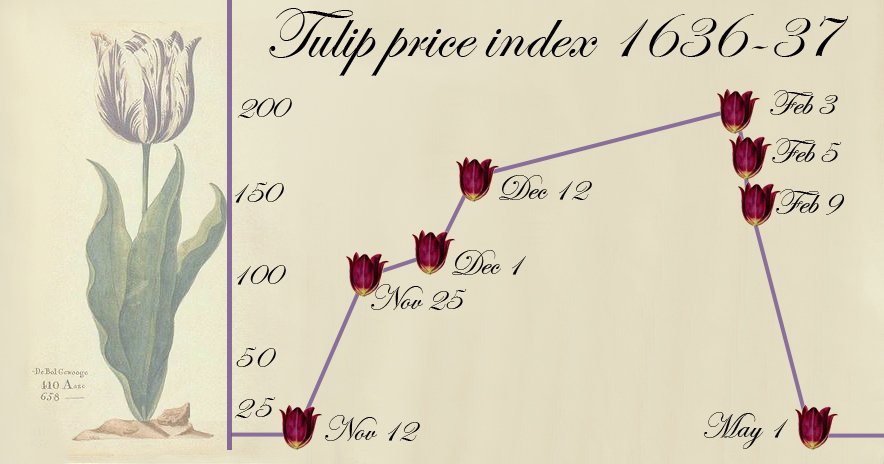I usually take my own photo of the Plant of the Week because I like to come up with a good one from my garden, but this week, let’s leave it to the pro, Claus Dalby.
Plant of the Week
Photo and information from Wikipedia: “A tulip, known as "the Viceroy" (viseroij), displayed in the 1637 Dutch catalogue Verzameling van een Meenigte Tulipaanen. Its bulb was offered for sale for between 3,000 and 4,200 guilders (florins) depending on weight (gewooge). A skilled craftsworker at the time earned about 300 guilders a year.”
The latin name on this one is a real bear. Ready? It’s ‘Tulipa’. Native to the drier parts of Central Asia, few flowers have been more intensely cultivated, manipulated, cross bred, and celebrated than the tulip. The Dutch Tulip mania of the 17th century cause a short lived economic sensation. The most popular specimens had a virus which caused their coloring to be ‘broken’.
From the Adam Smith Institute web site. Was it a ‘next fool’ scheme? Nahhh- couldn’t have been, and let us hope your NFTs do better.
Tulips come in all colors except a true blue, and I do love the frilly and striped ones. Keep in mind that variegation on any plant is actually a virus. Unlike COVID, it’s a very attractive virus, but one that weakens the plant at least slightly, so the ephemeral nature of tulips is usually. more pronounced in the fancy types.
Claus Dalby
Claus Dalby starts many of his videos with the cheering words ‘hello hello!’ and although I forgot to ask him to say those exact words for our zoom conversation, that vibe was ever present. The beauty that he creates, his enthusiasm for sharing, and his charming personality make the Claus Dalby Instagram feed and YouTube channel irresistible.
One of Claus’s garden rooms. There is always someplace to sit down to marvel at the beauty.
Claus gardens in Risskov on the outskirts of Aarhus in Denmark. He has created 15 garden rooms and now has 3 green houses on what was just a big lawn when he and his husband moved in.
As amazing as his rooms and borders are, I think Claus is most renowned for the arrangements of containers that he puts together.
“Vignette” is not quite the right word, as you can see from the photos above. The compositions he puts together are harmonious and elegant works of art, and they are expansive.
Claus has written many books, but his first one in English is new this spring. It’s called Containers in the Garden and you can buy it here.
Amazing photography and growing tips combine to make this a book you need to have in your collection.
Buy it straight away or enter the Giveaway below.
Giveaway— two winners!
To win either Claus’s new book OR
100 tulip bulbs from ColorBlends.
Just do the following…
1. Follow @LeslieHarrisLH on IG if you don't already
2. Follow @Colorblends on IG if you don't already 3. Follow @ClausDalby if you don’t already. WAIT. You don’t follow Claus Dalby?
4.. Rate and review Into the Garden with Leslie podcast
AND Shoot me an email at LHarris@LHGardens.com telling me you have entered by doing all of these things!
Coffee Time!
Please consider supporting Into the Garden with Leslie my buying me a cup of coffee
OR! Becoming a member of I’m into the Garden too!
I will send you some LH Gardens gear if you become a member!
The Play List—
a list of garden things…
When should you divide perennials?
What do you do with sticks and branches too big for the compost pile?
What is garden consulting?
When should you divide perennials?
Whenever you are in the mood, but perhaps not in the dead of winter (difficult to locate, among other issues) not the heat of summer (stress). I like to do it before rain, because I am a lazy water bearer. Some folks say only divide spring blooming perennials in fall, and fall blooming perennials in spring but personally having divided all sorts at all times, I can tell you that it’s just not that big a deal.
If this Siberian iris/donut could talk it would say “Hey! I wouldn’t be a donut if you divided me!”. I can hear him, I’ll get to it eventually.
Consider the simple fact that early spring division makes it so that the collateral damage incurred by a metal shovel in combination with tender foliage is far less dramatic. There’s just not as much to damage.
What do you do with sticks and branches too big for the compost pile?
Sticks in the compost pile is not a no-no necessarily. They will break down eventually and en route they create handy air dams in the pile. But if you are going to top-dress your beds with your compost, sticks just tend to look a little tatty. My rule of thumb is that anything the size of a pencil or smaller can go in, but the rest of the stuff, no.
Brush piles between my hemlock hedge and the deer fence.
If you don’t want to collect them for kindling, and happily, we don’t seem to be using our fire pits quite as much as we did in 2020, I recommend that you make brush piles of stick and branches on the outskirts of your property. Again, they will break down eventually and feed your soil, but in the meantime, they make excellent habitat for the insects and small mammals and even birds that we all welcome in the garden.
Okay, I may be projecting about the small mammals, and furthermore, you may be imagining some unwanted reptilian action. I get it, You may not want any part of this idea and it’s your garden. But if you have the space, some of your garden can be turned back to nature with this simple practice.
What is garden consulting?
It’s what I do in my not very much spare time, and I like to do it! Here’s a link to the page on my website that explains it, and it can be done virtually. I recently had a client in northen New Jersey!
Next Week
Clare Foster, editor of House and Garden Magazine, UK
Clare Foster, garden writer and editor















